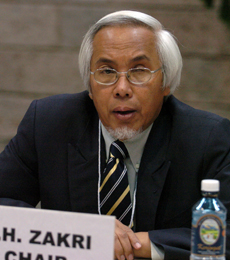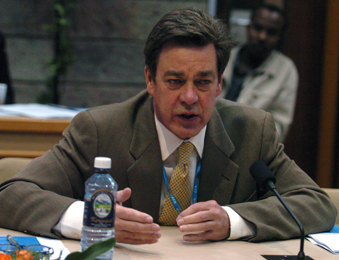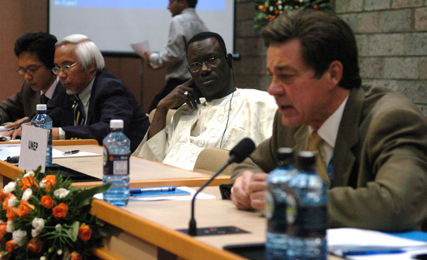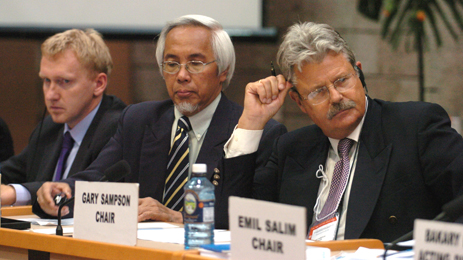|
|
|
|
High-level Brainstorming Workshop for MEAs on Mainstreaming Environment beyond Millennium Development Goal (MDG) 7
13-14 July 2005, Nairobi, Kenya |
|
|
|
|
|
|
|
|
|
|
Web archive: Wednesday, 13 July |
|
|
|
|
|
|
| Highlights from Thursday, 14 July |
On Thursday, 14 July, participants to the High-level Brainstorming Workshop for Multilateral Environmental Agreements (MEAs) on Mainstreaming Environment beyond MDG7 continued their discussions, focusing on identifying a medium and longer-term strategy for a possible plan of cooperation between the UN Millennium Project and MEAs, as well as on the Agreed Chairman's Summary on the outcome of the meeting. During the discussions on the Agreed Chairman's Conclusions, participants made a number of comments in restructuring and improving the text, which will be finalized and circulated to participants at a later stage. The text include issues discussed during the meeting and ways to address these issues. It also includes a section outlining goals for the future and measuring progress. In his closing remarks, Bakary Kante, UNEP, said that the objectives of the meeting have been met, which are to generate ideas how to cooperate more among the MEAs and with MDGs. The meeting closed at 6:30pm . |
Identifying a mid-term strategy for a possible plan of cooperation between the UN Millennium Project and MEAs |
 |
Jerry Velasquez, UNEP-GEF, A.H. Zakri, Director, UNU-Institute of Advanced Studies (UNU-IAS), Bakary Kante, Acting Director, UNEP Division of Environmental Conventions (DEC) and Director, Division of Policy Development and Law (DPDL), Alex Alusa, Deputy Director, DEC, and Philip Dobie, Director, Dryland Development Centre, UNDP
On identifying a medium term strategy for a possible plan of cooperation between the UN Millennium Project and MEAs, participants considered: linking MEA's mandates to MDGs; providing human and financial resources for MDG activities; building institutional capacity at national level; conducting dialogue between MEAs' national focal points and UND and its national offices; using adaptation for climate change and protected areas for biodiversity as starting point for such cooperation; and having UNEP act as facilitator to promote linkages between MEAs and MDGs. |
 |
|
| |
A.H. Zakri, Director, UNU-Institute of Advanced Studies (UNU-IAS) (left), chaired the session on identifying a mid-term strategy for a possible plan of cooperation between the UN Millennium Project and MEAs. He said that the challenge is to build strong bridge between MEAs and MDGs, noting two options of partnership: partnership between MEAs and Millennium Project, and partnership between Millennium Project and UNEP.
Bakary Kante (right) said that some MEAs do have competent mandates to implement MDGs at the national level, and with the MOU between UNEP and UNDP and the Bali Strategic Plan for Technical Support and Capacity Building, he said UNEP is ready to support such activities. He said adaptation to climate change can be an avenue to begin. He stressed that the partnership between Millennium Project and MEAs would not exclude any organization. |
| |
 |

|
|
Philip Dobie, Director, Dryland Development Centre, UNDP, stressed the need to get to tell people on the ground, especially policy makers, where and how environment is affecting poverty and how to solve the problem. Noting that MDGs are shifting international development assistance from project and programme support to budgetary support for country-set priorities, Dobie drew attention to the UNEP/UNDP poverty and environment initiative as a practical tool to mainstream environment in development strategies, which is expected to expand. He also said that, in the framework of the memorandum of understanding between UNEP and UNDP, an initiative will be started in September to deliver to UN country teams tools on how to mainstream environment into country strategies, and proposed an involvement of MEAs in this endeavor. |
|
| Anantha K. Duraiappah, Senior Economist, International Institute for Sustainable Development (IISD), Peter Bridgewater, Secretary General, Ramsar Convention on Wetlands, and Geoffrey Howard, Regional Programme Director, IUCN |
| Peter Bridgewater, Secretary General, Ramsar Convention on Wetlands (left), said while each MEAs will make their individual efforts to contribute to the achievement of MDGs, there is a need for a mechanism to promote cooperation between MEAs, and UNEP DEC should play a key role in this regard. |
Identifying a longer-term strategy for a possible plan of cooperation between the UN Millennium Project and MEAs
On identifying a longer-term strategy for the possible plan of cooperation, the following recommendations were made: undertaking some concrete country level activities; exploring new ways in which the environment can become part of the international effort to change the development paradigm; publicizing best practices in MEAs; involving industries, academics, scientists and celebrities in the MDGs and MEAs cooperation; and engaging celebrities in showing the importance of ecosystem services for combating poverty. |
| Jacob Duer, Programme Officer, Division for Environmental Conventions, UNEP, Chair Elim Salim, WSSD, Bakary Kante, UNEP and Alex Alusa, Deputy Director, DEC |
| Emil Salim, WSSD, chaired this session on a long-term strategy, and asked participants to focus on activities at national level, coordinating with the UN and development agencies. He also called for focus on mainstreaming environment beyond the 2005 World, and said that at national level environment must be considered a mainstream in the government systems, and on the long run, environment should be considered part of the broader human development process. He called for new ways in which the environment can become part of the international effort to change the development paradigm, with Philip Dobie, UNDP, acknowledging a systemic failure in integrating the environment into the development progress both by multilateral and bilateral development agencies. |
 |
|
| Foday Bojang, Head, Environment and Natural Resources Division, Focal point for the Bamako Convention, African Union Commission (left) and Peter Bridgewater, Secretary General, Ramsar Convention on Wetlands, and Geoffrey Howard, Regional Programme Director, IUCN, and Laurent Ntahuga, Regional Technical Coordinator for Biodiversity and Species, IUCN |
| Mahendra Shah, Senior Scientist, Land Use Change, International Institute for Applied Systems Analysis (IIASA) (left), said stressed the need to notify the UN and governments that efforts are needed on environment even beyond 2015. He suggested assigning a small group of people the responsibility to draft a strong message or statement for submission to WS calling for mainstreaming environment into the MDGs.
Shah with Schiko Kuwabara-Yamamoto, Executive Secretary, Basel Convention (right)
|
On identifying a mid-term strategy, Guido Schmidt-Traub, Policy Advisor, UN Millennium Project (left), stressed the need for systematically scaling up the support to countries' MDGs-based strategies, and suggested a coordinated approach by UNEP and UNDP to involve MEAs in responding to country-driven requests for assistance, to be announced at the September Summit.
David Runnalls, IISD, and Emil Salim (center) |
Discussion on the Agreed Chair's Conclusions
In the afternoon, the Secretariat presented an Agreed Chairman's Summary as an outcome of the meeting. Chair Sampson invited general comments on the text, noting that the summary is designed for the ED to bring the message to the 2005 World Summit. Participants commented on the text, and taking the comments and suggestions into account, presented a revised text. Participants expressed satisfaction with the revised the text, which included the issues discussed during the meeting, and the way to address these issues, and goals for the future, as well as ways to measure progress. |
| Bradnee Chambers, Senior Programme Officer, UNU-IAS, A.H. Zakri, UNU-IAS, Gary Sampson, Emil Salim, and Bakary Kante |
| Participants review the draft conclusions of the meeting |
| Emil Salim with Bakary Kante and with Gary Sampson |
During the discussions on a long-term strategy, specifically on international environmental governance, David Runnalls, President, International Institute for Sustainable Development (left), remarked that UNEP and MEAs can take some anticipatory steps to show that MEAs can coordinate their work without additional structures, in order to shape the debate at the 2005 World Summit. He also suggested that UNEP institutionalize the Millennium Assessment (MA) to report regularly, and suggested that UNEP's Executive Director engage celebrities in showing the importance of ecosystem services for combating poverty. .
Peter Bridgewater, Secretary-General, Ramsar (center), proposed that UNEP liaise with MEAs to bring the MA process forward, as well as creating a common platform for better communication, education and awareness raising. |
 |
|
| Hamdallah Zedan, Executive Secretary, CBD (right), said that mainstreaming the environment beyond 2015 should be highlighted, and also proposed a reference to development agencies in the text. |
| Marion Cheatle, Department of Early Warning and Assessment, UNEP |
Bakary Kante thanked all participants for their attendance on such short notice, which he said demonstrated a strong willingness to meet the objectives of the meeting. He said that this process has helped everyone to better understand the link between the MEAs and MDGs/Millennium Project. He said that UNEP will be supporting MEAs in providing technical supports to governments for achieving MDGs. |
|
| David Runnalls, IISD, with participants at the conclusion of the meeting (left) and ENB writer Changbo Bai with Schiko Kuwabara-Yamamoto, Executive Secretary, Basel Convention (right) |
| Photos from Wednesday's reception |
|
|
|
|
|
|
|
|
|
|
|
|
|
|